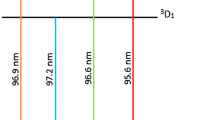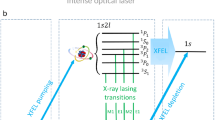Abstract
A detailed theoretical analysis is made of the x-ray level in metallic lithium with the object of understanding the effect of the electron-hole attraction on the soft x-ray emission spectrum. We regard the conduction electrons as independently scattering off the screened Coulomb field of the inner hole. We find that the resulting distortion of the Bloch functions increases the theoretical emission intensity severalfold. A qualitative general argument and an estimate of the lowest Born approximation to the scattering suggest that the emission spectrum is changed to show a falling intensity at the Fermi level, as is seen experimentally.
Résumé
On étudie la structure électronique du lithium métallique qui manque d'un K-électron afin de déterminer l'effet de la force attractif entre ce “trou” et les électrons de la bande de conduction sur le spectre d'émission des rayons X. Le champ “self-consistent” dû au trou blindé perturbe les fonctions de Bloch de la même manière qu'un défaut ponctuel ou une impureté ordinaire. Si l'on employait les fonctions d'onde diffusées au lieu des fonctions nonperturbées, la force d'oscillateur s'accroîtrait fortement et doublerait au moins. Des études générales et une estimation numerique jusqu' au premier ordre de la perturbation suggérent que la forme du spectre d'émission théorique serait moins en contradiction avec le fait expérimental, c'est à dire, le maximum d'intensité se trouve au dessous du niveau de Fermi.
Zusammenfassung
Es wird die Elektronenstruktur des angeregten Röntgenzustands in metallischem Lithium theoretisch untersucht, um die Wirkung der Elektron-Loch-Coulomb-Anziehung auf das Emissionsspektrum zu bestimmen. Die Leitungselektronen werden durch das abgeschirmte Loch in der K-Schale genau wie durch gewöhnliche Punktfehlstellen gestreut. Daher muß man bei einer Intensitätsberechnung gestreute Bloch-Wellen statt einfacher Bloch-Wellen verwenden. Dadurch wird die theoretische Emissionsintensität sehr vergrößert, mindestens verdoppelt. Allgemeine Betrachtungen und eine numerische Anwendung des Bornsehen Näherungsverfahrens führen zu dem Schluß, daß am Fermi-Niveau die neue theoretische Intensität als Funktion der Photoenergie abnimmt, wie man experimentell auch beobachtet.
Similar content being viewed by others
References
Skinner, H. W. B.: Repts. Prog. Phys.V, 257 (1938).
——: Phil. Trans. Roy. Soc. (London)A 239, 95 (1940).
Tomboulian, D. H.: The Experimental Methods of Soft X-ray Spectroscopy and the Valence Band Spectra of the Light Elements, Handbuch der Physik. Berlin-Göttingen-Heidelberg: Springer 1957, XXX, p. 246.
Cady, W. M., andD. H. Tomboulian: Phys. Rev.59, 381 (1941).
Landsberg, P. T.: Proc. Phys. Soc. (London)A 62, 806 (1949).
Raimes, S.: Phil. Mag.45, 727 (1954).
Glick, A. J., andP. Longe: Phys. Rev. Letters15, 589 (1965).
Rooke, G. A.: Phys. Letters3, 234 (1963).
Deodhar, G. B.: Bull. Am. Phys. Soc.10, 1222 (1965).
Azároff, L. V.: Revs. Mod. Phys.35, 1012 (1963).
Parratt, L. G.: Revs. Mod. Phys.31, 616 (1959).
Ham, F. S.: Phys. Rev.128, 82 (1962).
Skinner, H. W. B., andJ. E. Johnston: Proc. Roy. Soc. (London)A 161, 420 (1937).
Hayasi, T.: Sci. Repts. Tôhoku Univ.34, 185 (1949).
Skinner, H. W. B.: Proc. Roy. Soc. (London)A 135, 84 (1932).
O'Bryan, H. M., andH. W. B. Skinner: Phys. Rev.45, 370 (1934).
Bedo, D. E., andD. H. Tomboulian: Phys. Rev.109, 35 (1958).
Catterall, J. A., andJ. Trotter: Phil. Mag.4, 1164 (1959).
Crisp, R. S., andS. E. Williams: Phil. Mag.5, 525 (1960).
Mott, N. F.: Phil. Mag.44, 187 (1953).
Skinner, H. W. B., T. G. Bullen, andJ. E. Johnston: Phil. Mag.45, 1070 (1954).
Cohen, M. H., andV. Heine: Advan. in Phys.7, 395 (1958).
Jones, H., andB. Schiff: Proc. Phys. Soc. (London)A 67, 217 (1954).
Catterall, J. A., andJ. Trotter: Phil. Mag.3, 1424 (1958).
Fukuda, N., andR. G. Newton: Phys. Rev.103, 1558 (1956).
DeWitt, B. S.: Phys. Rev.103, 1565 (1956).
Van Vleck, J. H.: Revs. Mod. Phys.34, 681 (1962).
Goodings, D. A.: Proc. Phys. Soc. (London)86, 75 (1965).
Friedel, J.: Phil. Mag.43, 1115 (1952).
Mott, N. F.: Progress in metal physics, edited byB. Chalmers. Vol. 3. New York: Interscience, and London: Pergamon 1952, p. 98 ff.
Blatt, F. J.: Phys. Rev.99, 1708 (1955).
Langer, J. S., andS. H. Vosko: J. Phys. Chem. Solids12, 196 (1959).
March, N. H., andA. M. Murray: Proc. Roy. Soc. (London)A 266, 559 (1962).
Meyer, A., andW. H. Young: Phys. Rev.139, A 401 (1965).
Friedel, J.: Phil. Mag.43, 153 (1952).
Mott, N. F.: Proc. Phys. Soc. (London)A 62, 416 (1949).
Seitz, F.: The modern theory of solids. New York: McGraw-Hill 1940, p. 437.
Ferrell, R. A.: Bull. Am. Phys. Soc.10, 1218 (1965).
Bouckaert, L. P., R. Smoluchowski, andE. Wegner: Phys. Rev.50, 58 (1936).
Phillips, J. C.: Phys. Rev.104, 1263 (1956).
Slater, J. C.: Phys. Rev.36, 57 (1930).
Ham, F. S.: Phys. Rev.128, 2524 (1962).
Nutkins, M. A. E.: Proc. Phys. Soc. (London)B 69, 619 (1956).
March, N. H., andA. M. Murray: Proc. Phys. Soc. (London)79, 1001 (1962).
Gautier, F.: J. Phys. Radium23, 105, 738 (1962).
Mott, N. F.: Proc. Camb. Phil. Soc.32, 281 (1936).
Holöien, E.: Proc. Phys. Soc. (London)A 68, 297 (1955).
Callaway, J.: Phys. Rev.124, 1824 (1961).
Collins, J. G.: Proc. Roy. Soc. (London)A 263, 531 (1961).
Hwang, J.-L.: Phys. Rev.99, 1098 (1955).
Bagus, P. S.: Phys. Rev.139, A 619 (1965).
Allotey, F., andJ. J. Hopfield: Bull. Am. Phys. Soc.11, 331 (1966).
Author information
Authors and Affiliations
Additional information
Address 1966–1967: Laboratorium für Festkörperphysik, Eidgenössische Technische Hochschule, Zürich, Schweiz.
Rights and permissions
About this article
Cite this article
Shuey, R.T. X-ray excitons in lithium. Phys kondens Materie 5, 192–207 (1966). https://doi.org/10.1007/BF02422712
Received:
Issue Date:
DOI: https://doi.org/10.1007/BF02422712




